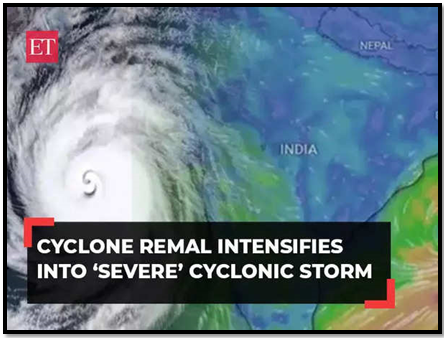“NATURAL DISASTERS: PREPAREDNESS, RESPONSE, AND LESSONS LEARNED”
Syllabus:
- GS-3- Disaster management and lessons that can be learnt from different countries
Focus :
- The focus of the article is on the unpredictability of natural disasters, the importance of preparedness, and the need for sustainable practices and advanced technologies to mitigate their impact. It highlights specific examples from the US, Japan, and Mexico, emphasizing the global necessity for effective disaster management and climate change mitigation.
Source - ET
Introduction
- Cyclone Remal serves as a reminder of nature’s unpredictability.
- The increase in global temperatures is partly due to human activities.
- Rising sea levels and increasing natural calamities are consequences.
- Major cities like London, New York, Chennai, and Bangkok are at risk of submergence.
- Scientists warn that urgent action is needed to mitigate these risks.
| NDMA:
1. Establishment of NDMA:
2. Creation of State and District Authorities:
3. National and State Plans:
4. Role of NDRF:
5. Funding Mechanism:
|
Natural Disasters in the US
- The Mississippi River region frequently experiences hurricanes and floods.
- Hurricane Katrina in 2005 caused extensive damage, submerging 85% of New Orleans.
- In 1927, a crucial decision to divert the Mississippi River with dynamite saved many from flooding.
- Despite advanced technology, the US struggles to prevent natural disasters effectively.
- Continuous floods cause ongoing challenges and devastation.
Japan’s Earthquake Preparedness
- Japan experiences 20% of all earthquakes of magnitude 6 and above.
- The 1923 Great Kanto Earthquake devastated Tokyo and Yokohama, killing over 140,000 people.
- Frank Lloyd Wright’s earthquake-resistant Imperial Hotel survived the quake, showcasing early disaster-resistant architecture.
- Modern Japan has developed advanced mechanisms to deal with earthquakes.
- Tokyo has quake-resistant reservoirs and food storehouses to sustain the city for 10 days during disasters.
Learning from Mexico’s Earthquake
- The 1985 Mexico City earthquake’s impact was felt 1,200 km away in Houston, US.
- Rescue efforts highlighted the effectiveness of trained canines in locating survivors.
- Despite technological advances, predicting earthquakes remains challenging.
- Mexico’s experience underscores the need for effective rescue and relief operations.
- Preparedness and quick response can significantly reduce the impact of natural disasters.
Global Perspectives on Natural Disasters
- China, Pakistan, and India frequently face earthquakes and other natural calamities.
- Massive loss of life and property is a common outcome of these disasters.
- Advanced prediction and preparedness can mitigate the impact but are not foolproof.
- The Parkfield Prediction Experiment in the US is an example of efforts to predict earthquakes.
- However, the reliability of such prediction mechanisms is still limited.
Addressing Climate Change
- Human lifestyle changes are necessary to combat rising global temperatures.
- Sustainable practices can help mitigate climate change and its effects.
- Governments need to enforce policies that reduce carbon emissions.
- International cooperation is essential for addressing global climate challenges.
- Investing in renewable energy sources and disaster-resilient infrastructure is crucial.
| About CDRI (Coalition on Disaster Reselient Infrastructure ):
1. Global Partnership:
2. Objectives and Launch:
3. India’s Initiative:
4. Membership:
|
Infrastructure and Technological Solutions
- Developing earthquake-resistant buildings and infrastructure is vital.
- Using advanced technology for disaster prediction and management can save lives.
- Countries must share knowledge and best practices in disaster preparedness.
- Building reservoirs and food storehouses can ensure sustenance during calamities.
- Continuous innovation and research are necessary to improve disaster management.
Community and Government Roles
- Communities must be educated and trained in disaster preparedness.
- Government policies should prioritize disaster risk reduction and management.
- Local authorities need to implement and enforce building codes and regulations.
- Effective communication systems can ensure timely warnings and evacuations.
- Collaboration between government, private sector, and NGOs is essential for comprehensive disaster response.
Conclusion
- Natural disasters highlight the need for better preparedness and response mechanisms.
- While technology can aid in predicting and managing disasters, it is not infallible.
- Sustainable development and lifestyle changes are crucial for mitigating climate change.
- Learning from past disasters and adopting best practices can enhance resilience.
- Continued efforts and global cooperation are necessary to protect lives and property from the ravages of nature.
Source:The Hindu
Associated article:
https://universalinstitutions.com/preparing-india-for-water-stress-climate-resilience/
Mains Practice Question :
GS-3
“Discuss the challenges faced by countries in preparing for and responding to natural disasters. How can technological advancements and sustainable practices help mitigate the impact of such calamities? Illustrate with examples from different regions..” (250 words)




